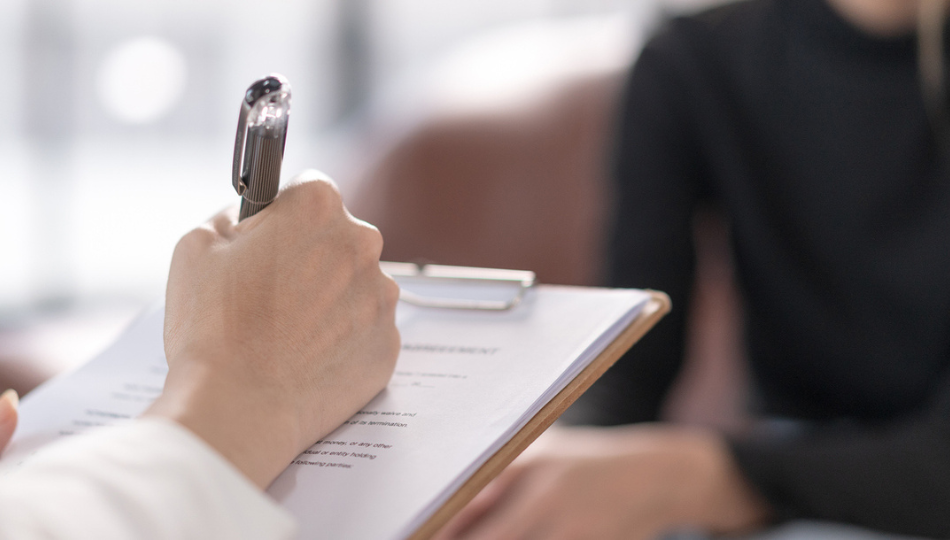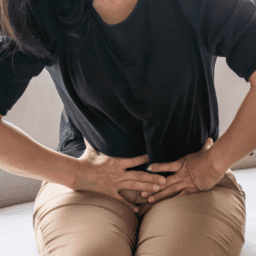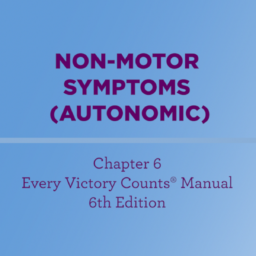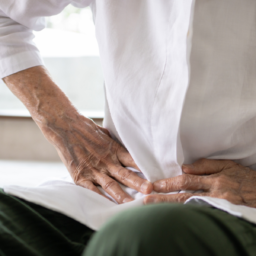Many people living with Parkinson’s have trouble with bladder overactivity that causes urinary urgency, frequency, and incontinence (unintentional leaking). Weak voiding and constipation are two other symptoms that significantly impact someone’s ability to live well. In this webinar, Michelle Spicka talks about the causes of pelvic floor dysfunction, how non-motor symptoms related to the pelvic floor may show up, and how to gain control of your pelvic floor so you can manage and mitigate these symptoms.
You can read the transcript below or you can download it here.
Note: This is not a flawless word-for-word transcript, but it’s close.
Melani Dizon (Director of Education, Davis Phinney Foundation):
Okay, so pelvic health and Parkinson's: Michelle, can you tell us about who you are and how you got into this work and how you got, you know, into working with people with Parkinson's in particular?
Michelle Spicka, DPT (Physical Therapist, Husker Rehabilitation and Wellness Centers):
Yeah. Well, my name is Michelle Spicka and I'm a physical therapist in Lincoln, Nebraska, and I graduated from Creighton University in Omaha with my doctorate in physical therapy 22 years ago. And so, I've been doing this for a while and 22 years ago, there was really no specialty in physical therapy about pelvic particular. We knew that there were issues. Of course, clearly, all of us have pelvic floors, which we'll find out and talk more about. But there was just nothing really being taught in school. And since that time, pelvic physical therapy has become its own specialty. We have so much more research on how we can help people with these dysfunctions. And so that's what ultimately led me to do this, but I started getting more focused about 20 years ago when I had some patients come into the clinic and maybe they were having neurologic issues or just orthopedic issues.
And they'll be like, you know, since my hip got stronger, I don't go to the bathroom all the time anymore. I said, well, what the heck is that about? So, I had to learn more and started taking more classes. And then I realized, oh my gosh, so many people have issues, and no one is talking about this. And then naturally that drifted into the world of people with neurologic issues and Parkinson's is a huge one. And we now have really good research that shows sometimes bowel and bladder issues are your first sign of Parkinson's some of those slowing down of your guts, some of those beginning urinary issues. And so that's what led me to become even more specialized, just naturally because of what I treat. And also, as more people are empowered to talk about these issues with their doctors, their doctors are offering other treatment options. So, I am glad to be here today. Again, I'm in Lincoln, Nebraska, is where I am, where it's right now looking at my computer, 98 degrees outside.
Melani Dizon:
Yeah, are we ever going to get out of this heat? It's crazy. So curious, actually you said that for a lot of people, this is one of the first signs that they notice something's wrong. Does anybody want to throw in the chat if this was true for them that you know, urinary constipation, anything around pelvic issues was a, was sort of a big, maybe it's in hindsight, you're looking back and saying, oh yeah, that I learned, I figured that was going on from a long time ago. Would love to know that. Okay. And then actually I'm going to wait for a second on the poll until we talk about the different ones so that people get a better sense of that. What is the pelvic floor? Let's talk about that.
Michelle Spicka:
Yeah. So that's like the mythical thing, like the pelvic floor, right? I, sometimes patients will come to me, and they'll say, "my doctor says I have pelvic floor dysfunction." What is that? Okay, what does that mean? Our pelvic floor is just kind of a gross grouping of the muscles that run from the front of our pelvic star cubic synthesis, the bone, like right down in the front of our lower abdomen, all the way back to our COIC. So, our pelvic floor muscles are actually made up of many, many little muscles, but we just call them the pelvic floor muscles because they all work together. It's kind of like, we have four different muscles in our quadricep, hence quad, quadricep, four muscles, but you don't just call, we don't separate them out unless you're in medicine, we just say quadriceps. Right. So, same thing with our pelvic floor.
But what we also know is our pelvic floor attaches to our hip muscles. It's all connected, our pelvic floor muscles are attached and work with our lower abdominal muscles our inside adductors. So, the muscles that attach up into the bones up in our pelvis area, in that Peral area, and also are glute muscles, all of those muscles work together neurologically, and they're very interconnected. So, when I say pelvic floor dysfunction, it's somewhere in that area. It isn't like one tiny muscle. That's the problem. It's more just this collective group of things that are causing issues. So that's when we say pelvic floor, it really is kind of the whole bottom of our trunk.
Melani Dizon:
All right. So that's a lot, that's a lot going on. So, to there, what are some of the most common pelvic floor dysfunctions that people with Parkinson's experience?
Michelle Spicka:
All right. So, I'm going to just kind of list out some of the most common things, and then we're going to come back and talk about them more in-depth. So, you are in urinary frequency. So go into the bathroom quite a bit. Normal is every two hours. This would be more than every two hours urinary urgency, where all of a sudden you're fine, and then you're not fine. And then you have to run to the bathroom that is urinary urgency. We can also see fecal urgency, although it tends to be a little bit more on the constipation. And so, we've already mentioned initially gastroparesis, which is slowing down of your gut and then constipation. Those are the kind of the bowel issues and some fecal urgency, but it's definitely more the constipation. Going back to our bladder, a big one is leaking urine at night when you're sleeping or having to get up multiple times at night.
All of a sudden you're getting up three times at night and you never used to have to do that before. Another thing is incomplete emptying. So, you're not able to empty out your bladder all the way. Like you go to the bathroom, and you get up and you're like, oh, I got to go to the bathroom again. What the heck? You know? And so, you're like, I was just in there, so that's incomplete emptying, and we can also see that incomplete bowel emptying. And that's a component of constipation too. And then urinary hesitancy where you have got the urge, I'm going to the bathroom, but then I get there and then I just can't pee right away what the heck is going on. So that is another sign of a disconnect in those muscles and the nerves.
Melani Dizon:
Okay. Do urinary tract infections fit in here?
Michelle Spicka:
So UTIs themselves are, are not caused by pelvic floor dysfunction, but pelvic floor dysfunction can make them more common. So, if you are not relaxing your pelvic muscles, so your bladder can empty out all the way, and you've got some urine pulling in that bladder that sets you up to have more urinary tract infections. Okay. So, it's not a causation, but absolutely it can contribute to it.
Melani Dizon:
Okay, great. Okay. So, this is a good time for a poll. I'm going to throw this poll up and I'd love for y'all to, to answer. If you're the person living with Parkinson's how frequently do you have symptoms related to your pelvic health? So, it's a daily concern. Maybe constipation is just a friend that you have all the time. A few days a week, a few times a month, a few times a year, or I don't have any issues related to pelvic health. Oh, my goodness. We are, we have, oh, 90 some percent that it's a daily concern. Well, excellent. We're all in the right place. Thank you so much for participating. Let's just do five more seconds. Okay. Okay. So, let's say we are about 95% are either daily concern or a few days a week. So that's a lot. And so, I really hope that today we get some great advice for you on some things that you can do. The great thing about Michelle is she works with people all day, every day on actual actions that you can take to, to help some of these issues. So, okay. Let's go back to where we started with naming off all the different ones. Let's start with urinary infrequency.
Michelle Spicka:
So, infrequency as in, oh, like going to the bathroom two,
Melani Dizon:
You said urinary, did you say frequency? OK. I was like, I wrote infrequency for some reason. Okay. Great
Michelle Spicka:
Frequency. Yeah. Well, infrequent that's urinary retention. So that, but that isn't as common. I mean, that is a neurologic thing, but that's not as common just to clarify for people. So, if you would have too much dysfunction, neurogenic bladder, sometimes you can get to urinary retention, but the biggest issue is irritability of that bladder so that your bladder just doesn't relax to fill and then gives you a normal signal. If you're drinking normal amounts of fluid throughout the day, we should be able to go to the bathroom every two hours or so now let's kind of get real briefly what is normal amounts of fluid, right? Because some people will, when they have urinary issues, to say, I'm just not going to drink, because if I just don't drink, then I don't have to go to the bathroom. Then I don't have to deal with it.
Well, then you're dehydrating yourself. And what's actually happening is that concentrated urine is irritating your bladder more. So, we really, even if you've got urinary frequency, just kind of a talking point, we'll talk about more treatment later on, but I'm just going to put a plug in right now. Make sure you're not Dey yourself. Because that's making everything worse. It's irritating your bladder more so than normal amounts of fluid in general, it's recommended that you drink half your body, weight ounces of water a day. And that would, and we're going to talk about bladder irritants later on when we talk about treatment. But so, if you're drinking roughly X number of ounces today, you want to, or space that out throughout the day, and you should be able to go to the bathroom every two hours. If you're going to the bathroom a lot more, then that is a dysfunction, not necessarily of muscle weakness.
It's mostly that the bladder is just kind of not relaxing to fill. So normally our bladder just sits like this. It relaxes as we fill it with urine until we get to a point, you know, and then it starts to signal, hey, you got to go to the bathroom and it's a normal signal. Well, what happens with urinary frequency is that the bladder just doesn't allow itself to relax and fill and is almost overactive. So overactive bladder, urinary frequency, really hands, same words, you know? So, it's kind of, there's no distinctive thing. So, if someone says you have an overactive bladder, well you have urinary frequency and urgency because it goes hand in hand. So just know if you get the diagnosis of overactive bladder, it's the same thing that I'm talking about now is urinary frequency and urgency. And then what happens is the more you have frequent urination, the stronger the urges get. So, then you go to the bathroom more and the more you go to the bathroom, the less your bladder wants to fill, and then it becomes this vicious cycle. So that's when we talk about urinary frequency and urgency.
Melani Dizon:
One second question about that is that because you're just training your body. Like if you, if you just keep going to the bathroom, like you're just, you're training it you're and then it's not going to function. So, we're actually good to hold. Like I'm just trying to understand that part of it.
Michelle Spicka:
Yeah. That's a good point. So, that's a training tool. So, there is so when normal human beings that don't really think about our bladder, when we get the urge to pee, we go to the bathroom because we don't want to have an accident. Now we don’t have an Ave leakage, but then what'll happen is that once we go into that dysfunctional realm of like going to the bathroom every hour, every 15 minutes, every half hour, there is a behavioral component because our bladder is kind of trained to empty sooner. So, part of the treatment is not to make you uncomfortable and tell you to hold it forever. But we start giving tangible tricks on how to be able to make it to the bathroom in time. And that when we talk about treatment and calming down that urge, I have a little trick that I can teach everyone today on how to calm down that urge, and it requires no equipment. So that's when we start, I'm not asking people, oh my gosh, don't hold your pee for four hours. That's actually super dysfunctional, but we want to kind of get to the point where you can gain control over that bladder. Again, even if it is a neurologic issue that's short-circuiting, we can still retrain our body a little bit and work around that.
Melani Dizon:
Okay. Okay, great. Let's see. Fecal urgency.
Michelle Spicka:
Yeah. So that goes hand in hand too. And the main thing that can cause fecal urgency is still kind of that neurologic, you end up with this hypersensitive rectum. That is a component I don't see as much in Parkinson's, definitely more constipation gastroparesis the slowing of the system. But if your rectum and I use my hands a lot to in the clinic to show you, cause we right. So, we can so anyhow so that now my hands, instead of a bladder, it's a rectum. So, if we know, if you are chronically constipated and you don't empty out your bowels, you kind of tend to pocket some poop in that rectum and our body doesn't like that. So, what'll happen is that it kind of reifies the poop around the stuff that's stuck in there and that's what can leak out or make it urgent. Mm. And that is fecal. Urgency is usually because something is sitting in there impacted maybe poop that is making it irritated, and your body wants to get rid of it.
Melani Dizon:
Okay. That's a lot. Okay. Let's I think we talked, we talked a little bit about nocturnal, right? Like leakage at night. Yeah.
Michelle Spicka:
At night. Yeah.
Melani Dizon:
Okay. And then I want to go, I want to go back to constipation at the end because it's such a big one. Let's just go through the next one. Incomplete emptying or incomplete bowel empty.
Michelle Spicka:
Yeah. So, both are the same dysfunction in some aspects. So incomplete bladder emptying. As when you sit there, go to the bathroom, think you're done. Get off the toilet and walk down the hall. And then all of a sudden have to go to the bathroom again. So, there's a couple different mechanisms for that. One of them is a neurologic one, the second one is muscle. So here is just a little bit about how our bowel and bladder function. So, in order for us to poop or pee, our pelvic muscles actually need to relax. So, our bladder can push out the pee and our rectal muscles, same muscle though, if it's external, anal stinker too, it needs to relax. So, our bowels can push out the poop, and our muscles don't push out the pee and poop. So, if our muscles are not relaxing all the way, then our bladder can't work, and our bowel can't work.
And so that cannot let it empty out all the way. So, if you're kind of only half relaxing, those muscles only half the pee and poop can come out. Now that's the muscle component. The other thing can be neurological. The signal to the bladder isn't getting there to have the strong enough bladder contraction to empty it out. Also, that bowel peristalsis, neurologically, that might not be working enough in our end tear system, which is our gut-brain system. It's part of our sympathetic nervous system, our automatic system, if that isn't strongly sending signals, that can also cause incomplete emptying. So, when you feel like you're not emptying out your bowel and you're not emptying out your bladder, it's because either neurologically it's not squeezing and we cannot control the bladder squeeze, we can't control the internal bowel squeeze that's neurologic or your muscles are not letting go so that you can empty out.
And I think I might just put a plug in real fast. We're going to talk about how to let that go. Right? Cause I don't want to forget. That's kind of important. So, you're thinking, oh my gosh, how do I get my muscles to let go? You know, you can't just sit on the toilet and tell yourself to relax. That does not work. If that worked. You guys would've figured that out a long time ago. Right? So, here's a trick with our breathing. So, when you're sitting on the toilet, when we breathe in our pelvic muscles automatically let go. And so, if you're straining and pushing and working too hard at it, you're actually fighting yourself so much. Those muscles never let go. So, all I need you to do, and we'll talk about using a Squatty potty later, because I'm a huge fan of putting your feet up on a stool, like a Squatty potty, but just even using your breath when you go pee inhale to let help those muscles relax and take some slow breaths, you'll find that it's easier to empty out your bowel bladder. So, I just want to put that plug in, you know, we kind of talked about treatment early, but I want to make sure that's okay.
Melani Dizon:
I get that, I love it. It's like, hey, the easiest thing we're doing it already. Just bring a little more intention to it. Right? We're breathing, you're there. Yeah. Bring
Michelle Spicka:
Some intention. Sometimes we have frustration that our bowel, bladder isn't working. Right. And we go sit in the toilet. You're like, oh, this isn't going to go good again. And you're already kind of tense because it's just frustrating that you can't pee, or you can't poop. If you can just focus on these simple things and say, you know what? I actually just need to let help those muscles relax. So, my body can do what it needs to do. We get in, we get in our own way all the time. So, we just need to not work so hard at moving to be quite honest.
Melani Dizon:
Okay, well let's go to constipation.
Michelle Spicka:
Yes. Oh my gosh. So, this is actually, I will say I see more people with Parkinson's with constipation issues than anything else. Also, for the record, I have a very large group of gastroenterologists in Lincoln, Nebraska that send a lot of patients to me. So, in general, I see urinary patients, but I definitely see exponentially more bowel issues. So naturally more of those patients are going to have a diagnosis of something neurologic in Parkinson's is definitely one of those. So, we know that constipation easily affects 60 to 80% of patients with Parkinson's. I think it could be almost a hundred percent and you know, I've read enough studies that say that's sometimes the number one, the first thing that shows up, but people don't even realize that, and then gastroparesis kind of goes with that because that's a slowing down of your gut system.
And so, there's many reasons for that neurologically your gut slows down. But also, if you're having nerve and muscle dysfunction, getting rid of the poop, it ends up being this whole traffic jam backed up. And so, if you are not able to empty out that bowel, you kind of just everything behind it slows down. So, it's like going from six-lane traffic down to one-lane and nobody knows how to zipper merge and it just ends up being dysfunction. So, a big part of what we work on is two things to get and I'm kind of jump ahead to treatment, but it just kind of seems to flow pretty well. We'll come back to treatment too, but we want to get, again, those pelvic muscles relaxing, but then also get the nerves working a little bit better. And there's one thing that we, I use a lot. That's one of the things for motility that seems outside of the medication work the best. And I actually use a lot of electrical stimulation like a little 10 unit on the low back area, low level electrical stimulation on this sacral area has been shown to help improve motility. And absolutely I'd say almost every single one of my patients with Parkinson's will get one for home. They're like $30 on Amazon, insurance does-
Melani Dizon:
Keep talking about it. I'm just going to grab my unit so I can show people what it looks like. But keep going.
Michelle Spicka:
We'll talk about tens units now because I think it’s hard to just talk, not without treatment. So, here's the deal. We have great research that if your bowel is slowed down, there's a few stimulant medicines that you can take, but we know it's a neurologic issue in a lot of patients, whether it be a spinal cord injury, MS, Parkinson's, anything, and there's good data that low-level stimulation on the sacral area, your low back, kind of where your dimples are, that can help stimulate those nerves just to make that rectum more sensitive and improve the internal squeeze, the peristalsis to push out that poop. Remember we don't push out the poop, our internal peristalsis, the bowel pushes out the poop. And when that motility is slowed, we have to help it out a little bit. And that is a hundred percent the tens unit that is, I think right now, $32 on Amazon, they usually have a Black Friday sale, and Amazon prime day, they got down to $26. So, you know, that's good. It's the TENS 7000. If you search TENS 7000 on Amazon, it is absolutely the best bang for your buck. There are way more-
Melani Dizon:
It comes in a little briefcase. So, you always got it.
Michelle Spicka:
Yep. That's exactly it. And there are more expensive units that are just crappy. So that is like, it's just a little dial thing. You put it on a low level. I have a protocol that it, it's very simple to use. I teach patients how to use that and you know, it usually takes, Hmm, it's not overnight. So, it usually takes several weeks up to 12 weeks is what research has shown. And most of my patients after about eight weeks tend to have improved motility. And the biggest thing is you have an improved urge to defecate and that's just a sign that everything is moving better on its own. So that's about constipation is just when everything is so slowed and we kind of, you know, our fighting ourselves, we're trying to push and that's making things worse. And you know, when we strain to have a bowel movement, you actually push the poop backward. That's not good because of the pressure. So, remember, we need those muscles to relax, so our bowel can push everything out. And so that's something that we work on just to improve the motility. So, constipation is a huge issue. And then, of course, side effects of medications, all those kinds of things can also contribute to it.
And so that’s another thing that, you know, we control what we can control, right? So, I can't control the side effects of medication, but maybe let's try other ways to help get those bowels moving. Now, if you want,
Melani Dizon:
Are there any medications in particular or would you say it's like pretty much runs the gamut? Like pretty much any of these medications that people are taking for Parkinson's neurological issues kind of contribute or can contribute to constipation and-?
Michelle Spicka:
Some pelvic you know, I would say, well because medications, you know, in general, have a side. So, I think every human being responds different to medication. Like you can have one patient, like even on, in talking to patients worldwide, right? I'm on this medicine. I have no side effects I'm on this medicine. I can't even tolerate it. Right. So, every human being, and I believe that sometimes my patients get constipated from medicine that, that isn't even the side effect, but hey, you know what, their body's becoming constipated. So sometimes it's hard to even know what medication it is. It could even be a combination of medicines or maybe a vitamin that you're taking. Maybe you're taking a ton of like heavy iron for some reason or something like that. And that is totally constipating you. So sometimes it's hard to do that because a lot of times with medications, these are things you need to take. Right. And so, we have to work around it. And so, when we talk in more about treatment, which, you know, I could just talk about, we can also talk about abdominal massage and all these things that we do that can help conservatively because that's my main job is that I'm not going to tell you to quit taking your meds that you need to take. Even if they're causing you horrible constipation, let's work around it and try and trick your body into work and better.
Melani Dizon:
Yeah. Well, I love, I mean, you're in business, so it's working, what you're doing is working and you can do things right. To improve your situation. So, a couple of questions really quickly, I'll show this again real fast. It's the 10, this is just like what you're going to get in the little package. It's these four little you know; you're going to put on your skin and then you keep putting their electrodes. You keep putting them back there. And then I had the little, I don't know what hap, oh, here it is. This is a tens unit. You can actually do a screenshot if you need to screen this, but we will definitely share this in the show notes. So, you can check that out. Before we move on to definitely some treatment. I do have a couple of questions. First of all, is there anybody here who has any pelvic floor issues that we have not talked about yet that you want to make sure that we do? Can you address the non-relaxing?
Michelle Spicka:
Yeah, that's the pelvic floor. That's too tight. That's just,
Melani Dizon:
We'll talk about that. And then things nighttime issues. Yes. We'll definitely talk about that. Okay. So, do males and females experience this pelvic floor dysfunction sort of at the same rate?
Michelle Spicka:
You know, I think like in the general public women, some women, it just depends on the type of dysfunction, right? So, when it comes to Parkinson's, I really feel like it probably is the same rate. I would, but as you know, in general, I believe the statistics say more men tend to have Parkinson's disease than women that just in general. So, in my clinic with men, with neurologic issues, there tend to be a little bit more men that have constipation issues in general. So many people have pelvic floor issues that we don't even talk about. I think the statistics will say 80% of women over the age of 40 have some 80% of women over the age of 40, have some sort of pelvic floor dysfunction and that's the general population. And that's whether it be prolapse and all kinds of other things that we can talk about that aren't related to Parkinson's so already it's super common in the general public. So, then you add a neurologic issue on top of it and then that magnifies it.
Melani Dizon:
Okay. All right, great. Let's go into it. How do people manage the various types of pelvic floor dis dysfunctions?
Michelle Spicka:
Yeah, so I think that, so let's just start, we'll go back to bowel issues because that we'll start there and then we'll go back to urinary issues, right? So, I'll just kind of give you a general overview of the teaching that I do in the clinic on how to get these issues. Now, I completely understand that every human being is a unique person has a unique story. So, some of these things that I'm going to say may not absolutely apply to you. You may have had five abdominal surgeries and have a ton of adhesions. You may have back issues where those nerves are getting pinched and that even further slows down nerve conduction people would, you know, back, you know, I saw spinal stenosis come quick. I'm trying to talk and look at some of those things at the same time. But yeah, if you already have spinal stenosis and that's already pinched some of those nerves in your back, that can even further cause some nerve dysfunction, that doesn't mean you can't treat it.
But so, we have to understand that everyone goes along with it, you may have neuropathy because of uncontrolled blood sugars and diabetes because that can cause nerve issues and dysfunction with your bowel and bladder. In addition to maybe having a hysterectomy in pelvic issues and some prolapse where your organs are falling down a little bit. So, I just have to look at what is every single person and what is your individual. So, when I give treatment recommendations here, understand that every human being is a little bit different. If you have a pacemaker or an implanted spinal stimulator, you cannot use that stem unit. Okay? You have anything implanted in your body that has a battery in it. Don't use that stem. So right there, I'm going to, I'm just going to put it. It is very helpful to improve sensation and motility in a lot of people.
But if you have something that's contraindicated, we can't do that. So, when it comes to constipation again, we're going to kind of go back to, I was really to, I'm going to kind of simplify it. This isn't the case for everybody, but there's two main reasons. You're constipated stuff isn't moving through or the door isn't opening up. And when you ask that question about non-relaxing tuba, reg Tellus, that's exactly what that is. Your muscles are too tight. Those pelvic muscles are not relaxing to allow your bowel to squeeze that out. Most likely that is either a neurologic dysfunction where your brain isn't sending the signals correctly to those pelvic muscles to relax, or you've strained so much through your life. Thinking that's how we're supposed to poop. Because again, no one talks about pooping. We all poop, right? Everyone raises your hand. We all poop or we want to poop.
So, we have to. So, but a lot of times, no one tells us how to poop. So, we develop really bad habits and straining is a really bad habit that is not helpful. We're fighting ourselves the whole time. And then if you strain so much, your body is afraid. You're going to push out something that you don't need. So, it actually tightens up and fights it. So, a lot of my patients will be like, it feels like I'm trying to push through a closed door. Well, you are because your body doesn't want you straining that hard. So then again, that's where we use some breathing techniques. Now we also know the human body hoops better. If we can be more in a squat position, many cultures in Asia, India, they have squat toilets, the incidents of constipation in Asia are very low actually compared to the United States in the United States.
We love our really tall toilets, right? The taller toilet. In fact, we renovated one of our bathrooms recently and we go to Menards, which is kind of like Home Depot in Lincoln, Nebraska. And I go, and I'm looking at all the different toilets. There's only one standard toilet. All the rest of them are comfort height, which means they're tall. The taller the toilet, the more your bowel is kinked. If you can get more in a squat position that helps to empty out your bowel. So simply putting your feet up on a stool or something called a Squatty Potty is great. It gets you in a good position. So that then those muscles can relax better. Because if you're sitting tall on a toilet and those muscles are tense, you're just really setting yourself up to struggle, to empty out. And even if you do get a little out, you're not emptying out all the way. And then the rest of its just kind of sitting there and getting irritated. So, if we can get you more in a squat position and comfortable, and then you're going to use some breathing again, as you're sitting in that position, you breathe in, remember breathing in, relaxes the muscle.
And even if you're sitting right now and all I need you to do is just sit comfortably. Don't you don't have to try and get in a squat position, but just breathe in and see if you can't feel those pelvic muscles coming down. Imagine when you breathe in, imagine the area between your, your sit bones are widening, use that visual imagery and that helps. And so, I briefly saw something about leaning forward is leaning forward. A good substitute. It, actually, leaning forward is better than nothing, but you really need to get those knees a little higher than your hips when you lean forward. You're just kind of changing that angle a little bit. Even if you have knee issues or back or hip issues, you can't tolerate a like seven-inch sweaty potty, just even a couple of books on both sides can make a big difference.
The one thing I don't want you to do is like holding up your legs, like trying to hold or being on your tip toes or holding up your legs, because then you're just tensing up your muscles more. So, the biggest thing is getting in that good position and then working on helping those muscles relax and then just rethinking what it is to poop. You know, just kind of focus on that relaxing. Now, sometimes people don't get the urge to poop, right? And so again, that's why we're using that electrical stimulation, very proven to improve that's. So, if your brain can feel more, that there's poop there, it sends a signal up to your brain that tells your muscles to relax. So that urge to go is important. So, it's really hard to have a bell movement if you don't have an urge to go. So, like, if you're just like sitting on the toilet because you think you need to poop because you haven't gone in a while, you sit there in strength, it's really hard because your body doesn't have that natural reflex.
And even if you have a lot of neurologic issues, we can retrain that reflex by getting that stimulation, working a little bit better for you. So, when it, the other thing about constipation that I teach my patients is abdominal massage. This is something that is, has no side effects and actually is part of a bell routine for anybody that has neurologic issues. And you always start in the right lower abdomen. I'm going to stand up for a second on my cell phone. So, here's my, you start here, and you can take a tennis ball or golf ball, and you're just going to slowly roll in this position. So, right lower all the way up to your ribs over and then down on that left side, then skip the middle because your bladder's there and you don't want to go poking on your bladder. Cause that doesn't feel good.
So, and then do this. So, you have to do it laying down. So, everything else is relaxed and you got to kind of get it moving. So, this isn't just really light massage. This is getting that body moving because if you can get those bowels kind of wiggling around, that's what sends signals to your brain. Hey, something's going on down here. We better get sending some more signals and that has been shown to improve motility. I absolutely teach patients partners. If they're not able to use a ball to massage on their own, I teach your partner how to do an abdominal massage with them. Just laying down on the bed, makes a big difference. Heat on your abdomen before you do that is really helpful. Heat relaxes those abdominal muscles so that everything works better.
Melani Dizon:
If somebody were to start doing that, how, how often should they do it? Is this like, hey, we just do it all the time? No five minutes, like multiple times a day? Or?
Michelle Spicka:
Yeah. So, with the bowel massage, most of our digestion happens at night. So, we need to rest to digest and the human body, although some people are a little different. We train ourselves differently. The human body actually usually does a lot of our bowel digestion at night. And then you have a bowel movement in the morning and then you forget about that's kind of normal, but let's face it. No, one's really normal, but that's textbook. So, in theory, you'll put some heat on your stomach at night and then do about five minutes of that circle massage before you go to bed at night, just to kind of see if that can't help. Now. I have some patients that do that in the morning because they feel it helps stimulate their bowels to move in the morning. Totally fine. So clearly there's not one correct time.
So just play with your own body, start at night, and then kind of go from there. So those are some of the main things that kind of globally can help with constipation knowing that everyone has different nuances. If you've had again, multiple surgeries, other nerve issues, other health issues that does have a play. If you've had a bowel section, clearly your bowels are going to function differently than others. If you've had major recusal, which is a pelvic prolapse on the rectum area repair, that changes things too. And so, we just have to, you know, so these are just some global things you can try, but if that doesn't work for you, don't get frustrated and don't think that, oh, none of this works. You just have to have your story, listen to have someone hear your individual story, and then teach you what to do based on that.
Melani Dizon:
Right. That's great. So, Peter asks "knees above hips." Yeah. I mean that's what happens when you're in the Squatty potty, that’s part of it for sure. The really great thing about the Squatty Potty is that it's not dangerous. Like we're not asking you to just go like squat, like in a hole, right? Like we, it's stable. It's sort of big, it goes around your toilet bowl at the bottom and super safe. You can just put your legs up there and then take them off when you're ready to go. How long, how often, and how long to use the stimulator if they were to get a TENS and if they, is it safe and comfortable, they, what would you say?
Michelle Spicka:
Yeah. So, I actually have a protocol that I've made up. So, I'll just say it. I can, I have a handout that I give patients, and Mel, do you just want me to, is there any way that-
Melani Dizon:
I could definitely do that. I think this whole group would just be-
Michelle Spicka:
I, not copyright, it's just my own protocol I just kind of made it up. so typically, I have a picture of where to put the electrodes, so basically, that'll be helpful. So, I will send that. When I, before I leave work today, I will attach that to an email to you, Mel, and then you'll have it. But roughly I'll just answer that question. It is TW about 15, 20 minutes once or twice a day and the key, and I'm going to stress this. And I put this on the note too, when you put that stimulation on, it needs to be low level. This is not the more, the better I'm going to fix myself right now. Okay. So, we want is to stimulate those nerves, to start working better, not irritate them and shut them down more. So, it's super key.
I hit that home with my patients. You really can't hurt yourself with a ten’s unit. It's run by battery. There is zero chance. They're going to electrocute you. It's not going to shock you. The biggest thing is that you just don't want to turn it up. So that's uncomfortable. You'll know it gets sharp and bitey and ugh. Okay. You want to just keep it low level. That's where it's helpful. So, 20, 15, 20 minutes once to twice a day, and that can make a huge difference. So, I'll send that it, it just shows a picture of where to put him. There's a big margin of error, but just kind of try and roughly put where the picture is.
Melani Dizon:
Yeah. And somebody saying how you know, part of it is like there are, there are a million videos on YouTube about how to use tens units. If you find a really good, you know, a reputable person they can share, there's also a lot of information that comes with the tens unit that you can read and say like, oh, why do I have to put it like this? And there's a couple of different things, but since Michelle has offered to share where the placement is, that's half the battle. It's really the big piece. So hopefully we can do that and then, you know, you can try it out. So, it's definitely great. Thank you so much for that, Michelle. Okay. Let's, let's move on to some other treatment areas that you help people with.
Michelle Spicka:
Yeah. So, okay. We'll kind of circle back to your bladder, right? And so again, a big issue is urinary urgency, right? Or UR, your urinary urgency and frequency. We kind of talked a little bit about managing that. So, there's a couple of other things that we want to talk about. Bladder irritants. We kind of talked about that a little bit. If your bladder's already irritable, kind of just, maybe it has that neurologic irritability. We talked about drinking water and not getting dehydrated because if you have more uric acid in your bladder, it will be a more concentrated urine and your bladder lining just doesn't like that. And so, it wants to get rid of it. And so, then it's more irritated. Things like-
Melani Dizon:
That's also, that's also a big constipation thing. You don't want to do that for constipation either, right? Yeah.
Michelle Spicka:
Yep. You do not want to get yourself dehydrated. And actually, our muscles need water and fluid to work. Right. And we move slower. We don't feel good when we're dehydrated. It's just, but the fear of constantly having to go to the bathroom is a driving factor for why people don't drink enough water, but just know that there has been no study that shows dehydrated people have less urinary urgency. It may feel like you're not going to the bathroom, but you're not helping your cause because it's not fixing anything. So, you might temporarily, okay, I'm not going to drink at all. I mean, I literally have patients who will dehydrate themselves because they have a doctor's appointment at noon, or they need to travel to a town an hour away and they don't want to stop two times. And so, they just won't drink or they'll, you know, and so that's just not super good, but also just know that bladder irritant, when our bladder's already irritated, things like caffeine, spicy foods, citrus, fruits, you know, certain things just watch your individual.
Now, these are just global things. And so, some people are like, I've drank coffee in my whole entire life, and I don't have a problem. Great. You probably don't have a problem. That probably isn't the issue. But I have had definitely some patients who are like, you know what? I used to drink a pot of coffee every morning. I'm down to one cup of, and oh my gosh, I don't go to the bathroom as great. That clearly is a bladder issue for you. But what'll happen is that whether it's neural, you know, because remember that overactivity of our bladder absolutely can be neurologic short-circuiting, but then it becomes behavioral when we're constantly feeding into that and going to the bathroom more. So, what do you do? You're like, okay, that's great, Michelle, what do I do? Because I constantly have to go to the bathroom and I'm miserable if I don't go.
So, this is where part of my treatment comes in. I have a little trick and we're all going to try it to help calm down your bladder and that urge. And you can use this for fecal urgency or urinary urgency, either one. So, our brain is a very smart organ, but it's also really dumb. So, the nerves that go to our toes are the same nerve roots that come out of that spine and go to our bladder. So, my trick is I'm going to stand up just because, and forgive me if I get out of the picture, but I'll try and keep it so you can hear me. Okay. So, when you really have to go to the bathroom and you get a lot of urgency too because that goes hand in hand, you got to go to the bathroom, and you get more urgency. The one thing I don't want anyone to do, which is not helpful, is what do we do when we really got to go to the bathroom and don't think we can make it kind of hold our breath, and then we kind of hurry, hurry to the bathroom.
Right? Okay. Not helpful because when you hold your breath and you squeeze, you're putting more pressure down and then you're just making that bladder more irritable and then you'll have some leakage on the way to the bathroom. So, what I want to do is give you an alternative. So, if you, you can do this in sitting or standing and I'm going to show you what's my hands. So again, if you really have to go to the bathroom, what I want you to do is keep your feet flat on the floor and curl your toes into the floor. Like you're an Eagle claw on the floor or like this, I'm going to show you with my hand’s kind of this motion. So not this motion, this motion, like you're curling those toes. Now keep them curled and take three slow breaths into your nose and out through your mouth.
Now when you blow out, you can feel how that helps to gently engage those pelvic muscles and it decreases pressure on your bladder. So, you keep those toes curled. You keep taking those breaths and what's going to happen is that urge is going to calm down a little bit. So, then you can uncurl your toes and start walking to the bathroom. Cause the more you feed into it, the stronger that urge gets. And then you're probably leaking. You can't get your pants down on the way to the bathroom. So, if that happens again, your kind of walking down the hall, you're like, I'm almost there. And then it hits again. Stop, curl the toes, take a few more deep breaths. So, same thing happens. There's and there's incontinence called key in the lock incontinence. Right? Totally fine. Drive my car until I pull in the garage. And then I can't get out of the garage and I'm peeing by the time I get to the house, right?
So, when I, you just start changing the pattern, quit doing it. I park the car. I go pee. I park the car. I go pee. Well, guess what? You're going to start to go pee before you park the car. Cause it just keeps going. So, what did you do before, if that's an issue for you, but stop the cycle? So, before you get out of the car, you can do this in sitting, curl those toes. You're sitting in the car, take a few deep breaths, gain control, then get out of the car, stand there, curl those toes, walk around the back of the car, and just do something different. And what you'll find is that you just totally distracted yourself and now all of a sudden you can make it easily to the bathroom. You didn't leak. So just start changing that pattern. What can we control?
I can sometimes we can't control when that bladder decides to spasm, but we can also trick our body into calming that down. You can't make it go away sometimes, but you can calm it down enough to help get to the bathroom time. The more you panic about it, absolutely the worse it's going to be. So that's my trick to start retraining your bladder. Now we also use that electrical stimulation to calm down that bladder irritability. Absolutely. That can make a big difference. Rarely with urgency and frequency. Rarely is this a pelvic muscle weakness problem. It's almost always a neurologic hyperactivity. Pelvic floor strengthening totally can be helpful in general, but kegeling or just doing a bunch of pelvic floor contractions is really not going to make a difference for urgency and frequency. That is a neurologic hyper overactive bladder. And then we, it's a behavioral thing because we feed into it.
So, it's a very real thing with your bladder, but then we totally make it worse because we're human beings and we don't want to not go to the bathroom. And I get that. So, this is how we can retrain some of those bladder issues and retrain some of our habits, not just do a bunch of strengthening. So, when I see patients in the clinic, absolutely we address all these issues and we will get to some strengthening, but in Parkinson's it per you knows, itself, rarely is it because your muscles are weak. It's almost always a kind of a neurologic dysfunction that then leads to us compensating and doing some things and not relaxing our muscles. Our muscles are, it's almost like a too tense issue. Not that they're weak. So that's my little trick about the bladder. Drink your water, curl your toes, and try to only go to the bathroom every two hours.
Melani Dizon:
Great. That is great. Let's see a couple more can DBS improve any of this. Is there any, is there anything that happens with Deep Brain Stimulation and the pelvic floor? I haven't heard, but-
Michelle Spicka:
Well, hey, you know what? You know, why not because it's neuro, right? Right. Your bladder dysfunction is systemically neurologic. I would say. Why not? You know, I don't know, but I mean we, I stimulate your, the peripheral nerves with that sacral stem all the time. I mean that’s something I do. I just don't know. I don't know if that's the correct answer to that. Yeah. I just, well, may be right.
Melani Dizon:
Let's see. I use the bridge exercise holding for a count of 15 and while still up, bring these together with a count of 15 to 20 that helps strengthen my internal muscles for both bladder and bowels. Is that what you're saying is actually not the thing you want to do or-
Michelle Spicka:
Well, I think that, I mean, that's a great exercise if you want to get it stronger, but in certain people, you don't need those muscles stronger. We need them to relax.
Melani Dizon:
So, it's really having control over is what you're trying to get. You want it to be strong when you want it to be strong. You want it to be relaxed when you need it to be
Michelle Spicka:
Relaxed. Yeah. That is the key. I need your muscles to contract, but I totally need them to relax.
Melani Dizon:
Yeah. Does DBS limit your use of a TENS unit? I would say yes. Right?
Michelle Spicka:
If you have an implanted stimulator yes. That it, I just don't mess with it.
Melani Dizon:
Yeah.
Michelle Spicka:
I just, I, you don't want to add another stem to anything that has a battery in it in your body. It's not, it's not going to mess up the brain stimulation. It can possibly run down that battery super quick. Because you're adding an external stimulus to your body that challenges any implanted thing. Okay.
Melani Dizon:
Somebody says, Ooh, DBS definitely helps with urgency. Okay, Mark. That is great. I'm glad that definitely helped for you. Any, is it possible to drink too much water in a day? And can we talk a little bit about, I know the nighttime thing is a really big issue and we're saying let's drink, let's have this, you know, we're going to have this amount, we're going to spread it out throughout the day. And normally we should go to the bathroom every two hours. Like what about at night? Like when, how do people that are just never getting sleep, going to, to pull this off with like having to get up all the time and then the urgency and this.
Michelle Spicka:
Okay. So, I’ll address the water and then we'll talk about that. Can you drink too much water? Absolutely. I, in fact, I just had this conversation with someone this morning. She literally drinks 120 ounces of fluid a day and she is a tiny person. That is way too much our, I mean, literally, our bladder can only handle so much. There's some truth to that. So that's why if you are drinking more than half your body weight ounces, so you take your weight, divide it in half. And you know, if you're 140 pounds and you're drinking a hundred ounces of fluid a day, that's probably too much. So, you are going to irritate your bladder. I mean, she, this, this patient, you know, she's drinking so much and she's frustrated that she goes to the bathroom all the time. Yeah. There's a behavioral component, but you're just drinking a ton of water.
Okay. So, at night, what do we do? So, one of the things is you want to make sure you quit drinking water or any fluid or any like liquid-y, like watermelon, anything like that or anything that raises your blood sugar for about two hours. So that bowl of ice cream, right before you go to bed, it's probably not helpful because that increases your urine production at night. So, you want to quit drinking fluid for about two hours. I understand some people need to take medicine, do that, but you just don't want to be drinking two whole glasses of water before you go to bed at night. A lot of my patients have found using that electrical stimulation, that again, that TENS unit before you go to bed can help calm things down. But the other thing I'm going to throw out there that is really related to getting up at night is sleep apnea.
That is undiagnosed. If you are not getting into that deep REM sleep, your body is never switching over into nighttime urine production. So, the reason we can make it much longer at night is that when we get into that deep level of sleep, our body actually slows down our kidney function. And then we pee less. Now over the age of 40, it is normal to get up one time a night. That is absolutely normal. So, if you're getting up once a night and you're over 40 that is normal. And so just, we kind of start thinking about some of those other things. Yes, sometimes it is behavioral. Sometimes it's just that you're a light sleeper or you have a dog that jumps on your bed at 2:00 AM and it wakes you up. So, then you pee, right? And so, then you get into that pattern.
So sometimes changing that at night is also just lying-in bed, taking some deep breaths, and deciding, do I really need to pee? Or am I just awake? And I've trained myself to pee because I'm awake. So, part of that, again, is behavioral. So, we can have a true dysfunction. Like we talked about, like maybe, maybe it is sleep apnea, neurologic issue, or you're just your urine or kidney issues. There's a lot of reasons, but don't, you know, kind of lay there in bed and take some deep breaths. And if that urge gets better, I have some patients that just even curler toes in bed, just to try and see if you can't go back to bed. And if you can, you actually didn't really need to go. It was just a habit.
Melani Dizon:
I think, you know, we, we talked about this before actually with sleep, is that, and I'm not speaking with somebody with Parkinson's, so I don't know the difference, but that a lot of times we think the need to pee woke us up. And so, we have to do, but it's, that's not actually what woke us up, but then we woke up and we do it. So, if we can stay like, oh yeah, like curl the toes, try something to, you know, get it off might be, might be helpful. Oh my gosh, we have, we are almost done, but I cannot go without, let's talk a little bit about medications because I know people are wondering about it, suppositories, laxatives, all of these things, diuretics, like people have used the gamut of things, right? Yeah. To help out. Does anything work, is anything definitely, you know, counterproductive? What, what, what about, what is your take on the medications that the people use?
Michelle Spicka:
Okay. Let's talk about bowels first because that's the thing you can buy the most over-the-counter stuff for. So, you can buy a lot less over the counter, bladder issues, and bladder medication, than bowel issues. In general, a stimulant lax that, if you want to stay away from, and I know doctors will prescribe a cleanse. There's a whole litany of medications to help stimulate those bowels. I always, I'm kind of a big fan of MiraLAX. It doesn't work for everybody, but you can take MiraLAX throughout your life. You can take it for the long term. MiraLAX little, I don't know who's taking MiraLAX or not, I'm just going to throw it out there. It works the absolute best if you take it at night and most people do good with less than a full dose. So, some people are like, I hate MiraLAX. It makes my poop all yucky.
Well, it's probably because you're taking way too much. And so, you're probably not taking it at the right time either. So, if you take it in the morning and then you poop all day long, you hate MIAX right? Because no one ever told me. So, if you take it at night, you always start low. So, I always tell my patients to start with the fourth of the cap or dose and then titrate up and then see if you can't find that right dose. So MiraLAX is good. For some people that really have issues emptying out their bowel, instead of a fleet’s enema, which acts as a stimulant enema, just a simple water enema can help get things moving and clean out your bowel. You'll feel a lot better, no stimulant, totally, totally safe. And that is something that is just a little bit of tap water.
You can just buy plain enema bulbs on Amazon or at your, you know, home health store or something like that. Just tap water, just squirt that. In fact, the colorectal surgeons in Lincoln, that's kind of their first line of defense for people that difficulty emptying out, maybe some neurologic issues that just can't feel like they empty out. That is a wonderful way. Not as a stimulant, totally safe. If you can drink it, you can squirt it in directly. It's very safe. So that's something you can try to, you can try all kinds. I have patients that take multiple combinations of all kinds of stuff. Of course, you want to have fiber, but if you have gastroparesis, you don't want to load up on the fiber because it just sits there and causes issues. So that's where sometimes you just have to listen to, again, I need to hear your story.
Your doctor needs to hear your story. We have to individualize it. I see a question about stool softeners. So that is kind of in the medical community kind of a little bit of a joke because school softeners recently through a lot of research, actually multiple research has found to have zero positive function, but it's a placebo. So, what they found is that stool softeners actually have a placebo effect, and it makes you feel like you're going better. And so that's great. And it worked the same as a normal diet. And so, there was no difference between people who took stool, softeners and not, but they perceived that it was easier to poop. And so, you know what that's okay. You could also just go without too, so there's really no great evidence that stool softeners help, but if they help for you, I wouldn't stop it. And then just forget that they don't work because if it's working for you and you're not out stool, software’s are not that expensive. They're not a stimulant. It works for them
Melani Dizon:
And they're not I mean, can we be either, they're not going to hurt you. I mean, obviously too many can hurt you, but since they don't really have any active work, they're probably-
Michelle Spicka:
Yeah. And if you're taking a ton of lax and stimulus, excellent. That's worse. So, yeah, so, fiber, if you need to MiraLAX every night, just titrate up that dose MiraLAX does work best. If you take it every night is not like random, it's not going to work good for you. If you take it like I'm going to take it because I haven't had a bowel movement in a few days. Right. Because how to take it consistently.
Melani Dizon:
And is that similar to, like, Metamucil, Benefiber, although Benefiber is different?
Michelle Spicka:
Right? Yeah. So, it's totally different. So, Metamucil, Citrucel, and Benefiber are fibers, and MiraLAX is an osmotic stimulant. Okay. But it's a shame, totally different. So, you can't take thinking you're taking MiraLAX.
Melani Dizon:
Great. Okay. And then one question that well actually two questions, because I know everybody's thinking the same thing. Oh yeah. Is there a way to determine if the sense of urgency is real versus a function of training oneself with frequent urination and also does that matter in terms of how you are treating it?
Michelle Spicka:
So, this is what I'll say. If you especially let's start with bowels and then we'll go with bladder. If you had a good bowel movement in the morning, and then you have more urgency throughout the day, it's possible that's not actually real, because you already had a good bowel movement in the morning with your bladder. If you have PE and it has not been even one hour and you have more urgency, you probably don't need to go. But this is the marker. I tell my patients if you go to the bathroom and you pee, if you cannot count to 10 for that stream of urine, you did not have to pee. That's a thousand CCS. Our bladder should be able to hold it. So, you sit there, you start your stream of urine one, two, and whatever count slope. If you are not peeing the whole 10 seconds, you did not need to go. You, you jumped the gun on that sucker.
Melani Dizon:
That is fascinating. Okay. That's a good rule of thumb, right?
Michelle Spicka:
Yeah. And it helps you figure it out now sometimes you'll go in and you count one, two. Oh, I guess I didn't really need that's how you train yourself
Melani Dizon:
Okay, great. Final question. Can, are you taking clients, and can people find you if they live near you in Nebraska?
Michelle Spicka:
Oh yes. I am taking new patients all the time and I do right now have a little bit of a waiting list. It, I mean, it's probably about three weeks at this point in time, but absolutely, I'm at Husker Rehab in Lincoln, Nebraska, and feel free to get ahold of me. Also, you know, if anyone has my contact information or anything like that, and you don't know where your nearest public therapist is, we have a big online database that you can look that up and find somebody that's close by you.
Melani Dizon:
Okay. That's fabulous. And everyone, I will make sure to put her link in there and get whatever information that we can. And if there weren't any, if there were questions that were missed feel free to always email me at blog@dpf.org. And if I don't have the answer, I will reach out to Michelle and hopefully, she can help out. Thank you so much, Michelle, really helpful. I feel like this is the most poop I've ever talked about, and I want to keep going. There are so many great tips for people. So, thank you so much for sharing with us today.
Michelle Spicka:
Thanks for having me. And I'll send that link to you today.
Melani Dizon:
Oh yeah. Great. I'll send that off to everybody. Thank you so much. Thanks. Bye, everybody. Bye.
To download the webinar audio, click here.
Show Notes
What are the different types of pelvic floor dysfunction?
There are many different types of pelvic floor dysfunction (PFD). However, there are several types of PFD that specifically affect people with Parkinson's. Those are:
- Urinary frequency and urgency - What happens with urinary frequency is that the bladder just doesn't allow itself to relax and fill. It's almost as if it is overactive. The more frequently you urinate, the stronger your urge to continue urinating. That will create a vicious cycle where you will continue to empty your bladder and therefore train it to not fill. To combat this, train yourself to hold in your urine as much as possible. This will allow your bladder to actually fill, stopping the cycle. You can learn more about urinary urgency and frequency here.
- Constipation and fecal urgency - Constipation is caused by the inability to defecate. Fecal urgency is when the body recognizes that it is constipated and therefore wants to frequently defecate. When it's easy to empty your bladder, neurologically, you will want to also empty your bowels. However, since there is that constipation aspect, the body cannot defecate and therefore starts the vicious cycle of fecal urgency. In order to combat this, Michelle suggested using a TENS unit muscle relaxer. It can help release the muscle tension that causes constipation and alleviate the symptoms of fecal urgency. Dr. Spicka also shared her protocol for using a TENS unit for constipation. However, please do NOT use a TENS unit if you have a pacemaker or other implanted medical device. As always, consult your medical care team before starting any new treatments on your own.
- Gastroparesis - Gastroparesis is a motility disorder in which food doesn’t move properly from your stomach to your intestines without an obstruction. (In other words, nothing is blocking the movement of food, but it won’t pass from your stomach to your small intestine as it should.) One of the ways to combat this is to make sure that you are using either shorter toilets (though these are difficult to find) or to use a Squatty Potty. Michelle let us know that the more your legs are lifted when going to the bathroom, the less your bowels are kinked up. That's why countries like Japan have squatting toilets. If you'd like to learn more about this, visit here.
Can Deep Brain Stimulation (DBS) help with PFD?
There is no specific data on whether or not DBS affects your PFD. However, since DBS does help neurologically, many neurological symptoms can be alleviated with DBS, and therefore your pelvic floor dysfunction may indeed be helped.
What are some strategies to help strengthen your pelvic floor?
- Bridge exercises: Lie down on the floor with your knees bent. Lift your pelvis up for 15 seconds, lower it back to the ground, lift it up for 20 seconds, lower it back to the ground, and then repeat. This exercise strengthens your abdominal muscles and your pelvic floor muscles.
- Drink less water. While staying hydrated is important, ensure that you are only drinking the amount of water you need, not an excess. Michelle told us the story of a 140-pound client who drinks 100 ounces of water a day. While that is definitely enough ounces of water to stay hydrated, the excess will exacerbate urinary frequency.
- Try MiraLAX. Make sure you consult with your doctor to ensure that MiraLax won't interfere with the medicine you take for your Parkinson's or other issues.
additional resources
What You Need to Know About Pelvic Floor Dysfunction and Parkinson's
Core Strengthening Exercises for Parkinson's Disease- Part 2 of 4
What You Need to Know About Urinary Tract Infections (UTIs) and Parkinson's
about the speaker
 Michelle Spicka, DPT
Michelle Spicka, DPT
A native of Wahoo, Nebraska, Michelle attended UNL for undergraduate studies and then graduated from Creighton University with a Doctorate in Physical Therapy in 2001. She began her work career at Bryan LGH Hospital in Lincoln, where she worked as a physical therapist in inpatient and outpatient settings. She transferred her knowledge of outpatient physical therapy treatment to Husker Rehabilitation and Wellness Centers in 2006. In addition to treating neurologic and orthopedic patients, Michelle specializes in pelvic physical therapy for women and men, including urinary and fecal incontinence, pelvic and abdominal pain, constipation, urinary dysfunction, diastasis recti, and pain during and after pregnancy. She lives in Lincoln with her husband Brian and their two children.
Missed this Webinar? Join Us Next Time! Register for our upcoming live webinars here.
Live Well Today Webinar Series Presenting Partners*
*While the generous support of our sponsors makes our educational programs available, their donations do not influence Davis Phinney Foundation content, perspective, or speaker selection.





















